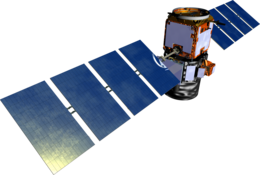CALIPSO
 CALIPSO | |
| Mission type | Earth observation |
|---|---|
| Operator | NASA / CNES |
| COSPAR ID | 2006-016A |
| SATCAT no. | 29108 |
| Website | www-calipso |
| Mission duration | Elapsed: 15 years, 9 months, 24 days |
| Spacecraft properties | |
| Launch mass | 587 kilograms (1,294 lb) |
| Dimensions | 1.49 m × 1.84 m × 2.31 m (4.9 ft × 6.0 ft × 7.6 ft) |
| Power | 562 W |
| Start of mission | |
| Launch date | April 28, 2006, 10:02:16 UTC |
| Rocket | Delta 7420-10C D314 |
| Launch site | Vandenberg AFB SLC-2W |
| Orbital parameters | |
| Reference system | Geocentric |
| Regime | Sun-synchronous |
| Semi-major axis | 7,080.7 kilometres (4,399.7 mi) |
| Eccentricity | 0.0001111 |
| Perigee altitude | 701 kilometers (436 mi) |
| Apogee altitude | 703 kilometers (437 mi) |
| Inclination | 98.2176 degrees |
| Period | 98.50 minutes |
| RAAN | 285.6451 degrees |
| Argument of perigee | 80.3481 degrees |
| Mean anomaly | 279.7840 degrees |
| Mean motion | 14.57093780 |
| Revolution no. | 40530 |
CALIPSO is a joint NASA (USA) and CNES (France) environmental satellite, built in the Cannes Mandelieu Space Center, which was launched atop a Delta II rocket on April 28, 2006. Its name stands for Cloud-Aerosol Lidar and Infrared Pathfinder Satellite Observations.
Passive and active remote sensing Instruments on board the CALIPSO satellite monitor aerosols and clouds 24 hours a day. CALIPSO is part of the "A Train", flying in formation with several other satellites (Aqua, Aura and CloudSat).
Mission[]
Three instruments:
- Cloud-Aerosol Lidar with Orthogonal Polarization (CALIOP) - a lidar that provides high-resolution vertical profiles of aerosols and clouds.
- Wide Field Camera (WFC) - a modified version of the commercial off-the-shelf Ball Aerospace CT-633 . It was selected to match band 1 of the MODIS instrument on the Aqua satellite.
- Imaging Infrared Radiometer (IIR) - used to detect cirrus cloud emissivity and particle size. The CALIOP laser beam is aligned with the center of the IIR image to optimize joint CALIOP/IIR observations.
In February 2009, CALIPSO switched over to the redundant laser as scheduled. The primary laser achieved its mission goal of three years of successful operation, and the redundant laser has been performing beyond expectations.
The CALIPSO mission was granted extended mission status in June 2009.[1]

See also[]
- A-train (satellite constellation)
- Earth Observing System
- List of spaceflights (2006)
References[]
- ^ "CALIPSO - INSTRUMENT UPDATE". NASA LARC. Archived from the original on 2010-03-16.
External links[]
| Wikimedia Commons has media related to CALIPSO (spacecraft). |
- Earth observation satellites of the United States
- Environmental science
- Satellites orbiting Earth
- Satellite meteorology
- Satellites of France
- Spacecraft launched by Delta II rockets
- Spacecraft launched in 2006
- NASA satellites
- 2006 in France